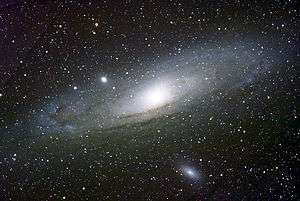Satellite galaxy


A satellite galaxy is a galaxy that orbits a larger galaxy due to gravitational attraction.[1] Although a galaxy is made of a large number of objects (such as stars, planets, and nebulae) that are not connected to each other, it has a center of mass, which represents a weighted average (by mass) of the positions of each component object. This is similar to how an everyday object has a center of mass which is the weighted average of the positions of all its component atoms.[1] Even within a satellite galaxy, the stars in turn orbit the galactic center.[2]
In a pair of orbiting galaxies, if one is considerably larger than the other, then the larger is the "primary" and the smaller is the satellite.[1] If two orbiting galaxies are about the same size, then they are said to form a binary system.
Galaxies which encounter one another from certain directions may interact: collide, merge, rip each other apart, or transfer some member objects. In these situations, it can be difficult to tell where one galaxy ends and where another begins. "Collisions" between galaxies do not necessarily involve collisions between objects from one galaxy and objects from the other, since galaxies are mostly composed of empty space. Rather, gravitational forces from nearby clouds of matter are capable of distorting one another, or bringing a clump of mass from one galaxy over into another.
The largest satellite galaxy of the Milky Way is the Large Magellanic Cloud.[3]
References
- 1 2 3 "Satellite Galaxies". mpg.de. Retrieved 17 August 2013.
- ↑ "What Is a Satellite Galaxy?". NASA Spaceplace. Retrieved 10 April 2016.
- ↑ "Our Galaxy and its Satellites Link for sharing this page on Facebook". Cseligman. Retrieved 8 April 2016.